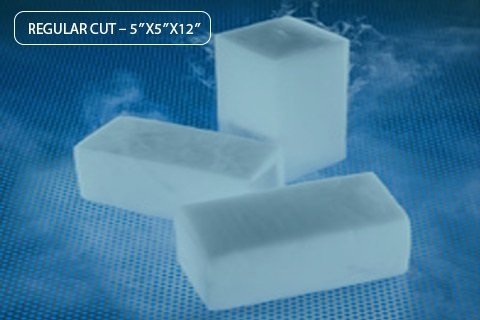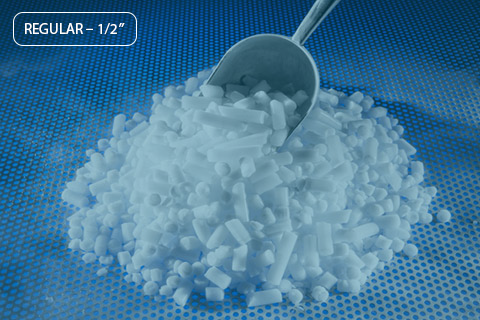What is Dry Ice?
Dry Ice is a solid form of carbon dioxide (CO2), frozen to – 109°F/78°C. It is referred to as dry because as it changes from solid to gas (sublimation) , it never goes through a wet stage. Carbon dioxide is what we exhale during breathing therefore it is a natural part of our atmosphere. It is also the gas used in carbonated water and sodas. It is a fast and simple way to freeze or transport frozen foods, medical and pharmaceutical products, and other materials that must be kept cold or frozen. Dry ice is non-toxic and is easy and safe to use when following safety guidelines. Please make sure to read and follow safe handling guidelines.
-
Dry ice sublimates at a rate of about 5-10 lbs. every 24 hours, if kept in a closed insulated container. Buy approximately 5 lbs. extra ice for every additional 24 hours.
-
Always handle dry ice with insulated gloves, never with bare hands. Dry ice is extremely cold and can cause skin to freeze, much like a cold burn.
Do not place in vehicle with closed windows or with A/C set to recirculate. When traveling with dry ice in vehicle slightly open windows for ventilation.
Keep dry ice out of reach of children and pets.
For use of large amounts indoors or in confined areas allow for plenty of ventilation in order to avoid breathing of carbon dioxide, which can be harmful. When used in a confined area open windows and doors. Never store in a room where someone is sleeping or where there are children or pets.
Do not store dry ice in an airtight container. If the carbon dioxide gas released has nowhere to go it can build up bursting or exploding the container.
Do not store dry ice in the refrigerator freezer, unless the freezer is broken. The extremely cold temperature could cause your thermostat to shut off.
Do not dispose of dry ice in sewer, garbage disposal or garbage chute. Gas can accumulate, build up pressure and damage pipelines. Allow leftover dry ice to sublimate (return to gas form) in a well-ventilated area.
- Never eat or swallow dry ice.
Overexposure to carbon dioxide can cause headache, difficulty breathing, nausea, vomiting or could lead to death. Do not use in small spaces with poor ventilation.



Uses & Applications
-
Dry ice is the best way to keep your frozen and refrigerated foods from spoiling in the event of a power outage as well as during shipping.
If you experience a power outage, place dry ice on the top shelf of your freezer and the bottom shelf of your refrigerator. If you are evacuating, placing dry ice in a cooler will allow you to transport your perishable foods or medicines safely.
-
Let the dent and surrounding sheet metal warm up by parking your car with the dent facing the sun. Then, following dry ice safety guidelines, put a small block of it over the dent.
The quick temperature change of the metal will "pop" the dent without damaging the paint. Do not touch either the dry ice or the extremely cold part of the car without gloves.
-
Dry ice pellets can be used to eliminate lawn pests without endangering people or family pets.
A handful of dry ice pellets placed down each hole will be enough to do the trick. Make sure to cover the hole with soil to seal the opening.
-
Carbon dioxide exhaled by people breathing is what attracts mosquitoes. A block of dry ice hung near a mosquito trap will simulate the carbon dioxide output.
-
Dry Ice can help rid your home of Bed Bugs, Mosquitos, Moths, etc.
Bed bugs, like mosquitos, are attracted to carbon dioxide. Dry ice can be used as bait in a bed bug trap.
Dry ice placed in 3mm thick trash bags can fumigate moths, moth eggs, and larvae, without using harmful chemicals. The moths, eggs, and larvae will suffocate as the oxygen is displaced from the bag. Place your wool and other clothing in a “contractor” bag along with 2-3 pounds of dry ice. Tie the bag loosely with a twist tie and once the dry ice has fully sublimated, seal the bag tightly.
-
To create a fog effect with dry ice, you will need a large container, hot water, and dry ice.
Fill your container halfway with hot water and add a few pieces of dry ice every 5-10 minutes to maintain the effect. One pound of dry ice will create 2-3 minutes of fog effect. Hotter water will produce more fog but will cause your dry ice to sublimate quicker.


